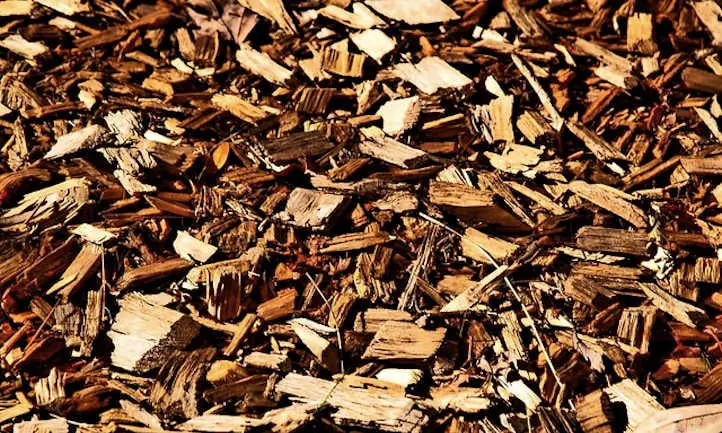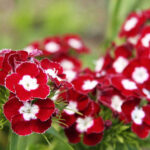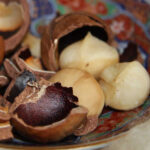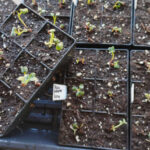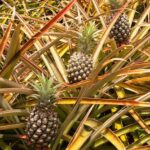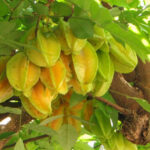One of the things landscapers and garden professionals tout time and again is mulch. There are many different types of mulch, such as leaves, grass clippings, or straw mulches like Garden Straw. But one widely used and sometimes controversial material is wood chip mulch.
Adding mulch along with compost is great for your plants. Still, there are debates as to which organic matter options are best for soil. Using wood chip mulch produces rich soil, as the Back to Eden method touts proudly. But using wood mulch may not be ideal in every situation!
So in this article, we’ll break down the benefits wood chip mulch provides to gardeners. With the right information and the right action, you can incorporate this incredibly useful material into your landscape and boost the growth of your garden.
What Is Wood Chip Mulch?
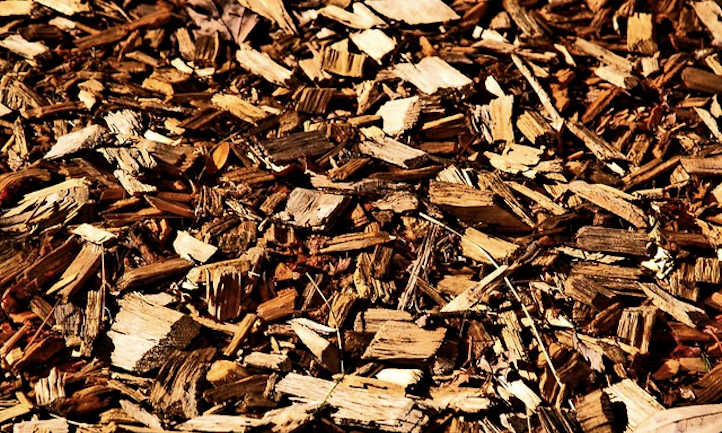
This is a huge question that we’ll break down for you here. It’s important to know which mulch is available to you and apply the appropriate materials to provide proper nutrients to your garden of choice.
Arborist Chip Mulch
This material is a source of chips that come from the byproduct of your local tree service or work done by arborists. It can include any part of a tree removed by an arborist or service: berries, branches, leaves, blooms, and even roots.
This is natural, organic matter that has been run through a wood chipper. Usually, it is the remnants of tree service that have been broken down into arborist wood chips. Sometimes this is old trees, and sometimes it’s fresh wood.
It’s also common to find arborist chip mulch available in areas where orchards are prevalent.
Bagged Wood Chip
You’ll typically find this at your local hardware store or plant nursery. It is mulched tree matter in 2 to 3-inch chunks. It could be natural and organic, tree matter directly from a lumberyard or a tree service, and it may be wood that has been chipped on a mass scale.
Most of the time bagged wood chips are from trees that have been used in industry, not from fresh and recently harvested wood. But getting these means you’re also getting plastic bags that you’ll be sending to the nearest landfill.
Modified Wood Chip
These could be bagged wood chips that have been treated to reduce their flammability. They may be treated with pesticides and herbicides which prevent weeds and insects from taking over your garden.
This material is often used in situations where a homeowners association has designated a preferred color of mulch. Sometimes they’re reflective or dyed a particular color. They may contain chemicals as well as organic matter.
Think of any wood chip that has been introduced to some form of additive to prevent disease, weeds, fire, or to colorize it. As before, it’s bagged, which means more plastic for the landfill.
Bark Mulch
Bark mulch is shredded tree bark that comes from varying sources. Most are directly from trees and people who work with trees. Other sources are sawmills and furniture manufacturers, just to name a couple. It’s an absorptive mulch that comes in flakes. It can often be full of slivers, and it can easily become matted together, but the fine particulate looks great in a garden.
Shredded Wood Mulch
This is the stuff you’ll see in neighborhood gardens. Shredded wood mulch may be dyed, but is usually finely shredded material such as pine shavings. Generally speaking, this is a finer size mulch of about 1” or smaller in size, making it quite visually appealing.
It’s generally a byproduct of lumber and paper manufacturing, and it’s spread to provide an aesthetic uniformity by retaining moisture and blocking out weeds. However, it comes with a drawback; it can sometimes be fine enough to become matted together and can slow drainage slightly.
Pros And Cons Of Wood Chip Mulch
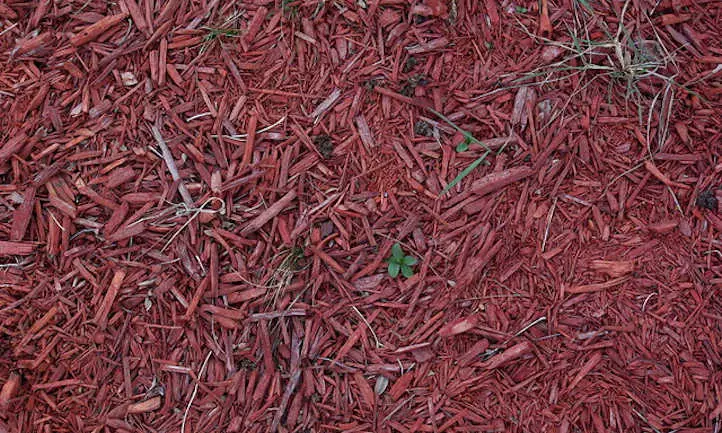
Let’s discuss the benefits and pitfalls associated with each as a source of mulch or compost. That way you have considered them before you are already using wood chip mulch at home.
Benefits
In general, wood chip mulch, when applied correctly, can be an excellent source of nutrients for your soil or compost pile. Wood chips also retain water in the soil, reduce weeds, and remedy topsoil erosion.
Ask any regenerative agriculture nut, and they’ll tell you wood chips simulate the same process that occurs on the forest floor, one of the richest environments around.
Wood chip mulch is a great way to prevent mud development in your garden because of its water retention properties. It looks great in any landscape, especially if you’ve managed to color coordinate. Some wood chips, like arborist wood chips, can even be free.
Adding a layer of wood chips to the ground to cover the soil surface, to reduce grass growth around trees, or to fill a muddy patch is a great way to carry out mulching in a natural way. Some modified wood chips keep pests out of the garden, allowing regular healthy growth to occur. Shrubs surrounded by a layer of red material can offset grass rather nicely.
Another great use for wood chip mulch is as a temperature regulator. Throughout the winter months, mulched plants often have warmer root systems, enabling them to withstand colder conditions much more readily. A thick layer of wood chip applied in the fall can be the factor that keeps your plants from severe weather damage.
Some types of mulch, such as aromatic cedar, can reduce pest populations. The aromatic nature of the wood acts as an effective deterrent.
If you’ve ever spread wood mulch you know it’s a great way to add a dash of pizazz to your landscape that will last for more than just one season. And when it does break down, you’re building rich soil!
Drawbacks

There are a few issues to consider, however, when it comes to working with wood mulch.
For one thing, many are concerned that these chips can pull nitrogen out of the soil. They do reduce the nitrogen level in the top inch or so of the soil, but further down the fertility of the soil is unaffected. This makes them a great choice for weed reduction, but not great if you’re starting seeds! Don’t mix mulch into the soil, as that puts the decomposing material closer to your plant roots.
They can choke plants and trees if they’re not used properly. The term “volcano mulch” is common in referring to trees with a mound of mulch right against the trunk. This style of mulching trees and other plants is dangerous, as it can cause damage to the trunk or plant’s base.
Compost and wood mulch together can make water retention too high for some plants and trees. They could experience root rot as a result. Usually, this is less of a problem for larger chip sizes, but it can be an issue in fine stuff like shredded barks or shredded wood chip.
Although colorful wood chips will last for more than one season, they do fade over time. For those looking for uniform color, you will regularly need to top-dress to maintain the right shade.
Mulches aren’t a comfortable surface for bare feet. Covering the soil surface with sharp material like arborist wood chips or shredded bark mulch may not be preferable to homeowners for this reason.
Termites may find fresh wood chips and want to make their way from that pile to your home. Although they aren’t technically “attracted” to tree mulch, they may find the layer of mulch a good temporary residence, and then move to the wood in your house once the mulch pile reduces. For this reason, it’s best to keep wood mulch at least two feet from your home. For a lot of people, this isn’t an option as garden beds are placed right near foundations, so you’ll need to keep an eye on it!
Mulch breaks down quickly and needs regular replenishment. It takes a lot of energy to do this. Even if you plan to hire a service to spread mulch for you, it can get costly. Bagged wood chips, modified wood chips, and tree bark need another layer at least every couple of years as they turn from fresh materials into a mix of decomposed waste. As they compost down, they’re improving the soil, but you’ll still need to make sure you top it off regularly.
Treated or modified mulch may not be the best option for your garden, especially where vegetable production is taking place. For instance, a modified mulch that contains Preen or another herbicide can reduce germination rates near the mulched area, and as a result, you may not be able to start seeds in that location.
There are concerns about disease being carried by certain types of tree mulch. While good fungi can live in your mulch, disease-causing fungi can too. This is especially a concern with arborist mulches, so it’s best to request mulch from trees free of diseases for your garden’s safety.
Finally, arborist mulches may only be available in large supplies. Many tree services want to just drop off a 10 to 20 cubic yard truckload all at once, and if you’re in a suburban area, you may find it difficult to handle that sort of quantity.
So consider what you need mulch for, and how you want to source the mulch before you make a large purchase.
Where To Use Wood Chips

Yes, wood mulch on the soil surface is a great way to mimic the soil of a rich forest floor. But there are right and wrong times to spread mulch. There are specific ways to layer them with compost, and correct ways to spread mulch around plants, trees, and shrubs.
Proper Timing
Mulch is not something you want to plant directly into. You should wait to even spread it on soil that you have recently planted seeds in. Wait for your plants to grow before adding mulch as a ground cover. This keeps developing roots open to nutrient absorption. This goes for transplants too… make sure roots are significantly developed before you add fresh mulch to the soil.
Proper Spacing
One very important thing to remember for adding mulch to soil in a vegetable bed or a place where trees, plants, and shrubs live is to avoid mulching directly to the stem or trunk. Leave some space between the plant, tree, or shrub and the mulch. This not only allows tree, plant, and shrub respiration, but it also gives them a little moat where moisture can collect and be used slowly and gradually.
The reason mulch gets the reputation of nitrogen-stealing has to do with improper applications like volcano mulching. Even if the mulch is organic and from a tree service where a healthy tree is chipped, too close or too much mulch is a recipe for disaster. Improper mulching can kill a plant.
Mulches should not be applied to the soil where plants are growing in a layer more than 4 inches deep. 2 inches is the minimum depth. Any less than 2 inches and weed suppression is not possible. If you spread mulch on the ground for suppressing weed growth, remember this!
In areas where you’re trying to prevent plant growth, a layer of 6-inch deep mulch is perfect. This prevents weed development and reduces the frequency of replenishing the mulch layer. 6 inches is great for pathways, for example.
Proper Sourcing
Make sure you’ve found a good source for mulch. If you want to grow vegetables, green mulch, or some hardwoods like walnut may not be the best option for your situation.
Most vegetable gardeners prefer softwoods like pine that breaks down easily so they don’t have to worry about improper plant growth.
Hardwood applied in the wrong situation can kill a plant. Some, like black walnut, are allelopathic and can actually reduce plant growth where they’re placed. While black walnut does decompose and the allelopathic conditions subside, it can take a while. Consider the tree species of mulch when you are planning.
If your mulch is purely an aesthetic choice, you may not need to worry too much about the source. But to make your organic gardening easier, you’ll want to make sure that the supplier you source from doesn’t include material that contains fungal pathogens or disease.
It’s terrible to have to come back from a free wood chip (which is great!) that is full of diseases and pulls nitrogen away from vegetables (bummer). Personally, it’s taken me years to come back from that in one of my vegetable beds.
Good sources for mulch are often local tree services or sites like ChipDrop. However, you can also get it from your local garden center, either bagged or in bulk. Typically, material from a garden center has been steam-sterilized, giving it an extra measure of protection from pest or disease transmission.
Building Soil
Maybe you prefer to use a mulch to build soil. In this case, it can contain green matter, and it can be hard wood. You can lay it in between beds to break down over time, or you can use it as a pathway. Green wood is great for this purpose as it’s still fresh from chipping, and may actually include some green leaves to provide nitrogen. This will reduce nitrogen loss as it breaks down, too!
Frequently Asked Questions
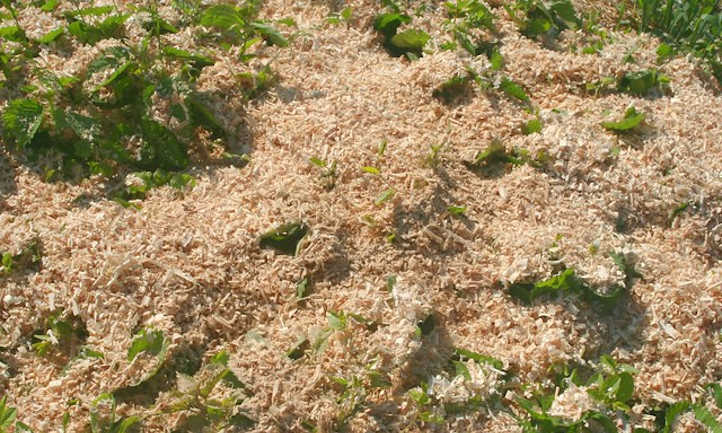
Q: What is the best wood chip mulch?
A: It depends! Each wood chip mulch has a different use, and each has its own appropriate applications. Organic options like arborist chips are often considered to be safest for the surrounding ecosystem.
Q: Does wood chip mulch attract termites?
A: Technically, no. But mulch too close to your home can encourage termites to move into the structure of your foundation. Keep wood chip mulch at least 2 feet away from your home to prevent this.
Q: Are wood chips good for a garden?
A: If they are used correctly, yes! They’re an excellent source of slowly decaying nutrients that replenish your soil.

